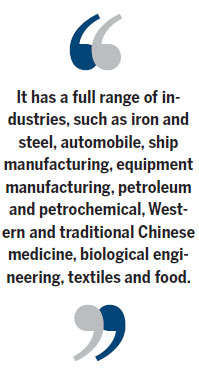Central city is the focus of green attention
Updated: 2015-11-20 08:08
By Tian Yan, Chen Weibin, Peng Yan and Zhao Guangjie(China Daily Europe)
|
|||||||||||
Wuhan taking sustainable path to reducing carbon emissions without sacrificing economic growth
As the Paris global climate change conference approaches, the whole world is focused on where and how to cut CO2 emissions. Wuhan, the biggest city in Central China, is no exception but faces relatively more severe challenges.
Why so? It is because Wuhan has a high proportion of heavy industry in its economic structure and has to ensure both stable economic growth and carbon emission reductions at the same time.
How to go about it? The city is keen to explore more efficient, effective and sustainable paths while taking action to make Wuhan "different every day".
Other cities - especially fast-growing cities in the developing world, might be experiencing the similar challenges and may find it useful to know how Wuhan approaches these challenges.
Wuhan is a strategically significant fast growing city in a transition economy. With a population of 10.2 million people, Wuhan is a major transportation hub and a key industrial base. The economic structure in Wuhan is mixed - with both hi-tech industry such as Optical Valley of China, and a traditional manufacturing sector such as Dongfeng Peugeot Citroen Auto Town.
It has a full range of industries, such as iron and steel, automobile, ship manufacturing, equipment manufacturing, petroleum and petrochemical, Western and traditional Chinese medicine, biological engineering, textiles and food.
Among Chinese cities, only Shanghai is comparable with Wuhan in industrial structure. This poses a tremendous challenge with substantial energy demand and a severe scarcity of resources. It imports 100 percent of coal, oil and natural gas, 48 percent of electricity and 80 percent of other energy.

However, the central government has designated Wuhan to be a model city of transformation. This means that it has to maintain high economic growth with low carbon emissions to play an effective role in Central China's development. Wuhan managed to reduce cumulative energy usage per unit of GDP by 24.73 percent in 2012, and the ratio of the hi-tech industry in the economic structure increased by 3.3 percent.
It is in this context that Wuhan was selected by the national government as one of the low-carbon pilot cities in 2012. This has strengthened Wuhan's confidence in going low carbon and made it keen to explore the best ways possible to achieve it. Wuhan has committed to, by 2020, reducing emissions per unit of GDP by 56 percent from 2005 levels, and the city has been striving for effective planning and implementation of low-carbon measures in order to meet the target.
Following an analysis of advantages and disadvantages, Wuhan decided to learn more from other cities to avoid reinventing the wheel and not to repeat their mistakes. Wuhan focused its innovation in two fronts: one is the integration of low-carbon targets into overall economic planning so that they become common components in all plans. Wuhan has established a series of innovative institutional mechanisms to enable more effective implementation of environmental programs, such as the Great East Lake Ecological Water Channel Network Project.
The other front was to create access to best practices worldwide. Wuhan has been working with the UK embassy in China and established strategic partnership with E3G, a UK-based organization on carbon measurement, and with the city of Bordeaux on Bilan Carbone methodology. It has also worked with the World Bank on low-carbon logistics and green freight, which was implemented by ITDP and Clean Air Asia.
The most innovative action Wuhan took was joining the C40 Cities Climate Leadership Group and the follow-up implementation. Wuhan is only the fifth city from China to join the C40 in June 2014, the others being Beijing, Shanghai, Hong Kong and Shenzhen. Among the four mainland cities, Wuhan and Shenzhen have already reported on climate data, a criterion for full membership of C40.
Wuhan has set 2049 as a target year to be a more competitive and sustainable world city. It is committed to take actions step-by-step starting from becoming a national central city in China, and then become a gateway city in the Asia-Pacific region, and finally a world city. Leapfrogging through innovation and learning from others is the best way forward.
Tian Yan is director of Wuhan Municipal Development and Reform Commission. Chen Weibin is director of Wuhan Research Center on C40 Cities Low Carbon Action (Wuhan C40 Center). Peng Yan is chief adviser of Wuhan Research Center on C40 Cities Low Carbon Action (Wuhan C40 Center). Zhao Guangjie is assistant to director of Wuhan Research Center on C40 Cities Low Carbon Action (Wuhan C40 Center). The views do not necessarily reflect those of China Daily.
(China Daily European Weekly 11/20/2015 page12)
Today's Top News
Suspected mastermind of Paris attacks died
Xi condemns murder of man taken hostage by IS
'Schweppes bomb' used to bring down Russian plane
Paris suburb raid targets suspected attack mastermind
France, Russia launch more strikes against IS
England fans sing French national anthem
France requests European support in Mid East
Hollande pressed to amend foreign policy
Hot Topics
Lunar probe , China growth forecasts, Emission rules get tougher, China seen through 'colored lens', International board,
Editor's Picks

|

|

|

|

|

|






